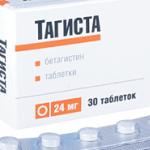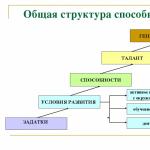Tagista is a drug that normalizes microcirculation in the so-called labyrinth; the drug is used for some pathology of the vestibular apparatus. For readers of Popular Health, I will consider this pharmaceutical in detail.
So, Tagist's instructions:
Composition of Tagist and release form
The pharmaceutical industry produces Tagista in tablets of a whitish-cream color, they are flat-cylindrical, there is a chamfer and a line. The active substance is represented by betahistine dihydrochloride in dosages of 8, 24 and 16 milligrams.
The excipients of the drug are as follows: microcrystalline cellulose, magnesium stearate, povidone, aerosil, potato starch, citric acid, talc. The medication is packaged in blisters of 10 and 30 pieces, and is also sold in small polymer jars packed in a cardboard box.
Pharmaceutical products are sold upon presentation of an appropriate prescription. The shelf life is three years, after which you should refrain from further use of the drug, as it will lose its therapeutic qualities.
Pharmacological action of Tagist
The drug Tagista affects histamine receptors, which are located in the inner ear and in the so-called vestibular nuclei of the central nervous system. As a result of the effect of the drug on the vessels, microcirculation of the capillaries improves, their permeability and endolymph pressure in such anatomical formations as the labyrinth and cochlea are normalized.
The influence of the active component betahistine helps to increase blood flow in the so-called basilar artery. The medication has a fairly pronounced central effect, normalizing conductivity in neurons located in the vestibular nuclei. Under the influence of the medicine, the patient's frequency of dizziness decreases, as well as their intensity, tinnitus decreases, and hearing improves.
Tagista tablets are absorbed quickly. The connection with blood proteins is quite low. Maximum plasma concentrations are observed within three hours. The half-life of the drug is three to four hours. The medicine is almost completely excreted in the urine throughout the day.
What does Tagista help with??
Tagista is indicated for use in the following situations:
The drug is prescribed for diagnosed vestibular vertigo, both as a treatment and for preventive purposes;
The medicine is effective for a syndrome including tinnitus, dizziness, nausea, headache, progressive hearing loss, and vomiting.
The drug Tagista is effective for diagnosed illness or Meniere's syndrome.
Tagist contraindications for use
Tagista is contraindicated for use in the following situations:
The medicine is not used until the age of eighteen;
Lactation period;
In case of hypersensitivity to the components of the medication;
The drug is not prescribed during pregnancy.
The pharmaceutical drug Tagista should be used with caution for peptic ulcers, diagnosed pheochromocytoma, and bronchial asthma.
How to take Tagista? Dosage
The drug Tagista is used enterally, that is, orally, during meals. The product is washed down with the required amount of water. Tablets at a dose of 8 mg are used 1-2 pieces up to 3 times a day; in a dosage of 16 mg, half a tablet form is prescribed or one piece at a time; 24 mg is usually used as a tablet twice a day.
An improvement in the patient's well-being is usually noted at the beginning of therapeutic measures, and a stable therapeutic effect can be noted after two weeks of treatment. Typically, therapy continues for quite a long time, which is determined individually.
Side effects of Tagist
When using Tagista tablets, the following side effects may occur: Quincke's edema develops, possibly a gastrointestinal disorder in the form of discomfort in the abdomen, in addition, hypersensitivity reactions occur in the form of a rash and itching of the skin, and urticaria is possible.
If such reactions occur to taking this pharmaceutical, the patient should consult a doctor. If the patient experiences other negative symptoms, then it is also important to promptly contact a treating specialist for symptomatic treatment.
Tagist overdose
Symptoms of an overdose of Tagista include nausea, often turning into vomiting, and convulsions. In such a situation, you should first rinse the patient’s stomach if no more than an hour has passed since the excessive use of tablets. Then the patient is recommended to be prescribed several tablets of activated carbon, after which he is given symptomatic therapy.
special instructions
The drug Tagista does not have a sedative effect, and therefore does not affect the ability to drive a vehicle.
Analogues of Tagist
Betanorm, Vazoserk, Betacentrin, Betagistin, Betaserk, Denoise, Alfaserk, Microzer, in addition, Betaver, as well as Vestibo. The listed drugs belong to the group of analogues of the drug Tagista.
Conclusion
Instructions for the drug TAGISTA, contraindications and methods of use, side effects and reviews about this drug. Doctors' opinions and the opportunity to discuss on the forum.
MedicineInstructions for use
Directions for use and dosage of TAGISTA
The drug is prescribed orally, during meals.
Tablets 8 mg - 1-2 tablets. 3 times/day.
Tablets 16 mg - 1/2 each - 1 tab. 3 times/day.
Tablets 24 mg - 1 tablet. 2 times/day.
Improvement is usually noted at the beginning of therapy, a stable therapeutic effect occurs after two weeks of treatment and can increase over several months of treatment. The treatment is long-term. The duration of treatment is determined individually.
Side effects of TAGISTA
Possible: gastrointestinal disorders, hypersensitivity reactions (rash, itching, urticaria), Quincke's edema.
Almost all medications have side effects. As a rule, this occurs when taking medications in maximum doses, when using a medication for a long time, or when taking several medications at once. Individual intolerance to a particular substance is also possible. This can harm your body, so if the medicine causes side effects for you, you should stop taking it and consult a doctor.
Overdose
Symptoms: nausea, vomiting, cramps.
Treatment: gastric lavage, taking activated carbon, symptomatic therapy.
Drug interactions
There are no known cases of interaction or incompatibility with other drugs.
Very important information that is not always taken into account when taking medications. If you take two or more drugs, they can either weaken or strengthen each other's effects. In the first case, you will not get the expected effect from the medicine, and in the second, you risk causing an overdose or even poisoning.
Active substance: betahistine dihydrochloride 16.0 mg; 24.0 mg;
excipients: microcrystalline cellulose, povidone (kollidon 25), potato starch, citric acid, colloidal silicon dioxide (aerosil), talc, magnesium stearate.
Description
The tablets are almost white or white with a creamy tint, flat-cylindrical with a chamfer and a score.
pharmachologic effect
Synthetic analogue of histamine. Acts on histamine H1- and NZ-receptors of the inner ear and vestibular nuclei of the central nervous system. Improves microcirculation and permeability of capillaries of the inner ear, increases blood flow in the basilar arteries, normalizes endo-lymph pressure in the labyrinth and cochlea.
The clinical manifestation of these properties is a decrease in the frequency and intensity of dizziness, a decrease in tinnitus, and an improvement in hearing if it is reduced.
Pharmacokinetics
After oral administration, betahistine hydrochloride is absorbed quickly and completely. Plasma protein binding is low. The time to reach maximum concentration in blood plasma is 3 hours.
Almost completely excreted by the kidneys in the form of a metabolite within 24 hours. The half-life is 3-4 hours.
Indications for use
Treatment and prevention of vestibular vertigo of various origins;
syndromes including dizziness and headache, tinnitus, progressive hearing loss, nausea and vomiting;
Meniere's disease or syndrome.
Contraindications
Hypersensitivity to any of the components of the drug; "
age up to 18 years
pregnancy
lactation
Directions for use and doses
Inside, during meals.
Tablets 16 mg: x/g - 1 tablet 3 times a day.
24 mg tablets: 1 tablet 2 times a day.
Improvement is usually noted at the beginning of therapy, a stable therapeutic effect occurs after two weeks of treatment and can increase over several months of treatment. The treatment is long-term. The duration of treatment is determined individually.
Side effect
From the side of the central nervous system: rarely - headache, drowsiness. >
From the cardiovascular system: rarely - feeling of heat, palpitations.
From the digestive system: epigastric pain, heartburn, nausea, vomiting. Allergic reactions", rash, urticaria, itching.
Overdose
Symptoms: dry mouth, nausea, vomiting, dyspepsia, loss of coordination of voluntary movements, facial flushing, dizziness, increased heart rate, bronchial spasm and swelling, and after taking very high doses, convulsions can also occur. Treatment: take activated charcoal and immediately seek emergency medical help.
Interaction with other drugs
Cases of interaction or incompatibility with other drugs are unknown.
Since betahistine is an analogue of histamine, its simultaneous use with antihistamines (loratadine, tavegil, Zyrtec, etc.) can cause a mutual weakening of the effect.
Features of application
Use with caution in case of gastric or duodenal ulcer (incl.
including a history), pheochromocytoma, bronchial asthma. These patients should be monitored regularly during the treatment period.
Influence on the ability to drive vehicles and other mechanisms that require increased concentration.
Betahistine does not have a sedative effect and does not affect the ability to drive a car or engage in activities that require rapid psychomotor reactions.
Tagista is packaged in blisters of 10 or 30 pieces. The medicine is produced in small jars made of polymer material. Packed in special cardboard boxes. The color of Tagista tablets is cream.
What does tagista help with?
The medicine Tagista is a good helper for anomalies of the vestibular apparatus, and will also help stabilize the microcirculation of the labyrinth. The doctor prescribes it if the patient has Meniere's syndrome, noise in the ears, a syndrome that is accompanied by mild dizziness.
The components that make up the drug tagista have the ability to influence the receptors of the brain and inner ear. The most effective component is betahistine dihydrochloride, and the additional ingredients of this drug are potato starch, citric acid, magnesium stearate and others.
During treatment, the patient's blood circulation improves, the vessels return to their normal position, and the endolymph pressure returns to normal. This medication can improve hearing and also minimize dizziness.
Contraindications for use
It is not advisable to take Tagist:
- During pregnancy, lactation;
- For urticaria;
- Hypersensitivity to some ingredients of the drug;
- Children and adolescents under eighteen years of age;
- Arterial hypotension.
Use with caution in patients who:
- Bonchial asthma;
- Intestinal ulcer;
- Allergic rhinitis;
- Ulceration of the gastrointestinal tract;
- Malignant adrenal tumor.
How and how much to take tagista
Tagista should be taken orally with food. Improvement in the condition usually begins already after taking the medicine. The use of the medication depends on the dosage. The medicine in a dosage of 25 mg is used twice a day as a tablet.
A stable result begins to be observed after about two weeks of use. The course of treatment is quite long, it can last more than one month. Your doctor will determine individually what dose you need for treatment. .
The active components of Tagist do not have sedative properties. Therefore, the medicinal drug cannot have an effect on a person while driving. In addition, any risky activities are not prohibited while the patient is undergoing treatment .
In order to purchase this drug, you need an appropriate prescription, which, of course, will be prescribed by your personal doctor.
The shelf life of the drug is approximately several years. After the expiration date, it is not advisable to use the drug, since the drug will no longer have any beneficial properties.
Tagista is absorbed quite quickly in the intestines and reaches its peak in the blood within a few hours. The combination of Tagista with plasma proteins is unlikely. The drug under consideration is completely eliminated by the human body within 24 hours.
Side effects
Like all medicines, these pills also have side effects. If a patient experiences various types of side effects from the medication, then he needs to urgently consult a doctor for symptomatic treatment.
Of course, adverse reactions from the use of this medication occur only in isolated cases.
The patient may experience:
- Various types of swelling, rashes;
- Nausea;
- Drowsiness;
- Epigastric discomfort;
- Increased heart rate;
- Anaphylaxis;
- Angioedema;
- Heartburn;
- Hives;
- Temperature difference;
- Quincke's edema.
The drug Tagista is a drug that improves microcirculation of the labyrinth, which is prescribed to patients with various pathologies and diseases of the vestibular apparatus. The active main component is betahistine dihydrochloride.
In this article we will look at why doctors prescribe Tagist, including instructions for use, analogues and prices for this drug in pharmacies. Real REVIEWS of people who have already used Tagista can be read in the comments.
Composition and release form
Tagista is available in the form of white or cream-colored flat-cylindrical tablets for oral use with a score line on one side. The tablets are packaged in blister packs of 10 pieces or in plastic jars of 30 pieces in a cardboard box with detailed instructions included.
- active substance: betahistine dihydrochloride 16.0 mg; 24.0 mg;
- excipients: microcrystalline cellulose, povidone (kollidon 25), potato starch, citric acid, colloidal silicon dioxide (aerosil), talc, magnesium stearate.
Clinical and pharmacological group: a drug that improves microcirculation of the labyrinth, used for pathology of the vestibular apparatus.
Indications for use
Can be prescribed by a doctor for: “ringing” in the ears; labyrinthitis; persistent decrease and loss of hearing; cerebral atherosclerosis; vertebrobasilar insufficiency; traumatic encephalopathy; inflammation of the vestibular nerve; dizziness after neurosurgical operations.

pharmachologic effect
Tagista belongs to the pharmacological group of histaminomimetics, the active substance of which is Betahistine.
Its use improves the microcirculation of the labyrinth; it is used for pathologies of the vestibular apparatus. Betahistine acts on histamine H1 and H2 receptors in the inner ear, as well as on the vestibular nuclei of the central nervous system.
Tagista not only improves microcirculation, but also capillary permeability, it is able to normalize endolymph pressure in the labyrinth and cochlea, and blood flow in the basilar artery increases.
Instructions for use
According to the instructions for use, Tagista tablets are taken orally before meals, it is advisable not to crush or chew the drug, and take it with a sufficient amount of water. The dose of the drug is determined individually for each patient, and the dosage of the tablet itself is also taken into account.
- 8 mg tablets – 1-2 tablets. 3 times/day.
- Tablets 16 mg – 1/2-1 tablet. 3 times/day.
- Tablets 24 mg – 1 tablet. 2 times/day.
Improvement is usually noted at the beginning of therapy, a stable therapeutic effect occurs after two weeks of treatment and can increase over several months of treatment. The treatment is long-term. The duration of treatment is determined individually.
Contraindications
The drug should not be used in the following cases:
- hypersensitivity to any of the components of the drug;
- age under 18 years (due to lack of data);
- pregnancy (due to lack of data);
- lactation period (due to lack of data).
The drug should be prescribed with caution for peptic ulcers of the stomach and duodenum (including a history), pheochromocytoma, and bronchial asthma. These patients should be monitored regularly during treatment.
Side effects
Taking Tagista may be accompanied by:
- Heartburn;
- Urticaria;
- Feeling of heat;
- Epigastric discomfort;
- Angioedema;
- Headache;
- Vomiting;
- Anaphylaxis;
- Tachycardia;
- Nausea;
- Drowsiness (in rare cases);
- Itching;
- Epigastric pain;
- Exacerbation of bronchial asthma;
- Exacerbation of gastrointestinal diseases with ulceration.
Exceeding the dosage of Tagista is accompanied by nausea, vomiting, and convulsive reactions. As a primary aid, lavage of the gastrointestinal tract and the administration of sorbents (for example, activated carbon) are indicated.

Analogues of Tagist
Structural analogues of the active substance:
- Asniton;
- Betaver;
- Betahistine;
- Betaserc;
- Betacentrin;
- Vasoserc;
- Vestibo;
- Westicap;
- Denoise;
- Microzer.
In this article we will look at why doctors prescribe it, including instructions for use, analogues and prices for this drug in pharmacies. Real REVIEWS from people who have already used it can be read in the comments.


















